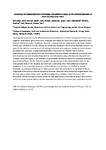Evaluating the competing effects of lithology and sediment supply on the erosional dynamics of rivers crossing active faults.
| dc.contributor.author | Whittaker, A | |
| dc.contributor.author | Boulton, Sarah | |
| dc.contributor.author | Kent, E | |
| dc.contributor.author | Zondervan, Jesse | |
| dc.contributor.author | Hann, M | |
| dc.contributor.author | Watkins, S | |
| dc.contributor.author | Bell, R | |
| dc.contributor.author | Brooke, S | |
| dc.date.accessioned | 2019-04-04T08:53:07Z | |
| dc.date.available | 2019-04-04T08:53:07Z | |
| dc.date.issued | 2017-04 | |
| dc.identifier.uri | http://hdl.handle.net/10026.1/13606 | |
| dc.description.abstract |
Lithology and sediment supply influence the erosional dynamics of rivers crossing active faults and together these effects govern the style, timescale and means by which landscapes respond to their tectono-climatic boundary conditions. Here, for transient bedrock catchments in the Gediz Graben, Turkey, and the Gulf of Corinth, Greece, for which the timing and rate of active faulting is known, we quantify the relative importance of rock strength and sediment supply on models of fluvial incision. We determine rock type, strength and erodibility using a Schmidt hammer and structural measurements of joint density and size. We evaluate the downstream distribution of channel width and stream power and calculate the extent to which the latter scales with tectonic rates and rock strength. Sediment supply is constrained using estimates of bedrock exposure, transport capacities and erosional fluxes. For the Turkish examples, stream powers in the metamorphic rocks are four times greater than in the Neogene sediment units, indicating a four-fold difference in bedrock erodibility, K, for a two-fold variation in in Schmidt hammer hardness. In the Gulf of Corinth examples, we interpret differences in stream powers near the active faults to represent order of magnitude differences in bedrock erodibility between carbonate and sandstone/conglomerate units. We also observe that in both cases, significant along-strike variation in fault slip rate is not associated with an increase in stream power for the sedimentary rocks and we assess the extent to which this stream power deficit may also represent the effects of sediment-flux-dependent incision. | |
| dc.format.extent | 11779-11779 | |
| dc.language.iso | en | |
| dc.rights | Attribution-NonCommercial-ShareAlike 4.0 International | |
| dc.rights | Attribution-NonCommercial-ShareAlike 4.0 International | |
| dc.rights.uri | http://creativecommons.org/licenses/by-nc-sa/4.0/ | |
| dc.rights.uri | http://creativecommons.org/licenses/by-nc-sa/4.0/ | |
| dc.title | Evaluating the competing effects of lithology and sediment supply on the erosional dynamics of rivers crossing active faults. | |
| dc.type | conference | |
| dc.type | inproceedings | |
| plymouth.volume | 19 | |
| plymouth.publisher-url | http://adsabs.harvard.edu/abs/2017EGUGA..1911779W | |
| plymouth.conference-name | 19th EGU General Assembly | |
| plymouth.journal | EGU General Assembly Conference Abstracts | |
| plymouth.organisational-group | /Plymouth | |
| plymouth.organisational-group | /Plymouth/Faculty of Science and Engineering | |
| plymouth.organisational-group | /Plymouth/Faculty of Science and Engineering/School of Geography, Earth and Environmental Sciences | |
| plymouth.organisational-group | /Plymouth/REF 2021 Researchers by UoA | |
| plymouth.organisational-group | /Plymouth/REF 2021 Researchers by UoA/UoA07 Earth Systems and Environmental Sciences | |
| plymouth.organisational-group | /Plymouth/Users by role | |
| plymouth.organisational-group | /Plymouth/Users by role/Academics | |
| dc.publisher.place | Vienna | |
| dcterms.dateAccepted | 2017-04-01 | |
| dc.rights.embargoperiod | Not known | |
| rioxxterms.licenseref.uri | http://creativecommons.org/licenses/by-nc-sa/4.0/ | |
| rioxxterms.licenseref.startdate | 2017-04 | |
| rioxxterms.type | Conference Paper/Proceeding/Abstract |



